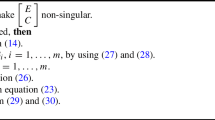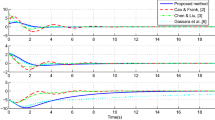Abstract
Often models are used for controller design that was identified under the objective to well approximate the system under study. In this paper, a scheme for identifying discrete-time locally affine Takagi–Sugeno (TS) models is presented, which better reflects the dedicated model use for designing a TS controller. For this purpose, after an initial open-loop experiment and controller design step, additional experiments are carried out in closed loop, each followed by an identification and controller design step. The deployed TS controllers are of parallel distributed compensator type but augmented by parallel drift and steady-state error compensation. The focus in this work is on a complete method that is simple and usable for real-world applications. To illustrate the practicality of the method, it is demonstrated on a laboratory-scale three-tank system.









Similar content being viewed by others
References
Abonyi, J.: Fuzzy Model Identification for Control. Birkhäuser, Boston (2003). doi:10.1007/978-1-4612-0027-7
Ackermann, J.: Sampled-data control systems: analysis and synthesis, robust system design, 1 edn. Communications and Control Engineering Series. Springer-Verlag Berlin Heidelberg (1985). doi:10.1007/978-3-642-82554-5
Albertos, P., Piqueras, A.S.: Iterative Identification and Control. Springer, London (2002). doi:10.1007/978-1-4471-0205-2
Babuška, R.: Fuzzy Modeling for Control. International Series in Intelligent Technologies. Kluwer Academic Publishers Group, Dordrecht (1998)
Bezdek, J.C., Ehrlich, R., Full, W.: FCM: The fuzzy \(c\)-means clustering algorithm. Comput. Geosci. 10(2–3), 191–203 (1984). doi:10.1016/0098-3004(84)90020-7
Dou, L., Zong, Q., Sun, L., Ji, Y.: Excitation signal design for closed-loop system identification. In: Chinese Control and Decision Conference, pp. 1471–1476 (2009). doi:10.1109/CCDC.2009.5192214
Fang, K., Shenton, A.T.: Constrained optimal test signal design for improved prediction error. IEEE Trans. Autom. Sci. Eng. 11(4), 1191–1202 (2014). doi:10.1109/TASE.2013.2264810
Analysis and Synthesis of Fuzzy Control Systems: A Model Based Approach. Automation and Control Engineering Series. CRC Press, Boca Raton, FL (2010). doi:10.1201/EBK1420092646
Gevers, M.: Identification for control. Annu. Rev. Control 20, 95–106 (1996). doi:10.1016/S1367-5788(97)00008-4
Gevers, M.: Identification for control: from the early achievements to the revival of experiment design. Eur. J. Control 11(4–5), 335–352 (2005). doi:10.3166/ejc.11.335-352
Gómez-Skarmeta, A., Delgado, M., Vila, M.A.: About the use of fuzzy clustering techniques for fuzzy model identification. Fuzzy Sets Syst. 106(2), 179–188 (1999). doi:10.1016/S0165-0114(97)00276-5
Graybill, F.A.: Matrices with applications in statistics, In: Duxbury Classic Series (2 edn). Wadsworth International Group, Belmont (1983)
Hjalmarsson, H., Jansson, H.: Closed loop experiment design for linear time invariant dynamical systems via lmis. Automatica 44(3), 623–636 (2008). doi:10.1016/j.automatica.2007.06.022
Hsiao, C.C., Su, S.F., Lee, T.T., Chuang, C.C.: Hybrid compensation control for affine TSK fuzzy control systems. IEEE Trans. Syst. Man Cybern. B Cybern. 34(4), 1865–1873 (2004). doi:10.1109/TSMCB.2004.830338
Johansen, T.A., Hunt, K.J., Gawthrop, P.J., Fritz, H.: Off-equilibrium linearisation and design of gain scheduled control with application to vehicle speed control. Control Eng. Pr. 6, 167–180 (1998). doi:10.1016/S0967-0661(98)00015-X
Johansen, T.A., Shorten, R., Murray-Smith, R.: On the interpretation and identification of dynamic Takagi–Sugeno fuzzy models. IEEE Trans. Fuzzy Syst. 8(3), 297–313 (2000). doi:10.1109/91.855918
Jørgensen, S.B., Lee, J.H.: Recent advances and challenges in process identification. In: Proceedings of the 6th International Conference on Chemical Process Control, vol. 98, pp. 55–74 Tucson, Arizona (2001)
Kim, E., Kim, S.: Stability analysis and synthesis for an affine fuzzy control system via LMI and ILMI: continuous case. IEEE Trans. Fuzzy Syst. 10(3), 391–400 (2002). doi:10.1109/TFUZZ.2002.1006442
Kroll, A.: On choosing the fuzziness parameter for identifying TS models with multidimensional membership functions. J. Artif. Intell. Soft Comput. Res. 1(4), 283–300 (2011)
Kroll, A., Dürrbaum, A.: On control-specific derivation of affine Takagi-Sugeno models from physical models: Assessment criteria and modeling procedure. In: IEEE Symposium Series on Computational Intelligence. Paris, France (2011)
Kung, C.C., Su, J.Y.: Affine takagi-sugeno fuzzy modelling algorithm by fuzzy c-regression models clustering with a novel cluster validity criterion. IET Control Theory Appl. 1(5), 1255–1265 (2007). doi:10.1049/iet-cta:20060415
Li, Y., Tong, S., Li, T.: Hybrid fuzzy adaptive output feedback control design for uncertain mimo nonlinear systems with time-varying delays and input saturation. IEEE Trans. Fuzzy Syst. 24(4), 841–853 (2016). doi:10.1109/TFUZZ.2015.2486811
Ljung, L.: Perspectives on system identification. Annu. Rev. Control 34(1), 1–12 (2010). doi:10.1016/j.arcontrol.2009.12.001
Narasimhan, S., Rengaswamy, R.: Multiobjective input design for system identification – frequency selection for identification of nonlinear systems. In: 14th IFAC Symposium on System Identification. Newcastle, Australia (2006). doi:10.3182/20060329-3-AU-2901.00183
Nelles, O.: Nonlinear System Identification: From Classical Approaches to Neural Networks and Fuzzy Models. Springer, Berlin (2000). doi:10.1007/978-3-662-04323-3
Schrama, R.J.P.: Accurate identification for control: the necessity of an iterative scheme. IEEE Trans. Autom. Control 37(7), 991–994 (1992). doi:10.1109/9.148355
Schrodt, A., Kroll, A.: Drift term compensating control for off-equilibrium operation of nonlinear systems with Takagi-Sugeno fuzzy models. In: Proceedings of the 14th European Control Conference (ECC), pp. 392–397. EUCA, Linz, Austria (2015). doi:10.1109/ECC.2015.7330575
Schrodt, A., Kroll, A.: Using an iterative and affine closed-loop identification and controller design scheme for Takagi-Sugeno models. In: Proceedings of the 17th IFAC Symposium on System Identification (SysID), pp. 362–367. IFAC, Beijing, China (2015). doi:10.1016/j.ifacol.2015.12.154
Sugeno, M., Takagi, T.: Multi-dimensional fuzzy reasoning. Fuzzy Sets Syst. 9(1–3), 313–325 (1983). doi:10.1016/S0165-0114(83)80030-X
Tanaka, K., Wang, H.O.: Fuzzy Control Systems Design and Analysis: A Linear Matrix Inequality Approach. Wiley, New York (2001)
Wang, H., Yang, G.H.: Controller design for affine fuzzy systems via characterization of dilated linear matrix inequalities. Fuzzy Sets Syst. 217, 96–109 (2013). doi:10.1016/j.fss.2012.10.006. Theme: Control Systems
Wang, T., Tong, S.: Observer-based output-feedback asynchronous control for switched fuzzy systems. IEEE Trans. Cybern. (2016). doi:10.1109/TCYB.2016.2558821
Xie, X., Yang, D., Ma, H.: Observer design of discrete-time t–s fuzzy systems via multi-instant homogenous matrix polynomials. IEEE Trans. Fuzzy Syst. 22(6), 1714–1719 (2014)
Xie, X., Yue, D., Zhang, H., Xue, Y.: Control synthesis of discrete-time t-s fuzzy systems via a multi-instant homogenous polynomial approach. IEEE Trans. Cybern. 46(3), 630–640 (2016). doi:10.1109/TCYB.2015.2411336
Xie, X.P., Liu, Z.W., Zhu, X.L.: An efficient approach for reducing the conservatism of lmi-based stability conditions for continuous-time t–s fuzzy systems. Fuzzy Sets Syst. 263, 71–81 (2015). doi:10.1016/j.fss.2014.05.020. Theme: Automatic Control
Zhang, Z., Lin, C., Chen, B.: New stability and stabilization conditions for t–s fuzzy systems with time delay. Fuzzy Sets Syst. 263, 82–91 (2015). doi:10.1016/j.fss.2014.09.012
Acknowledgements
This work was supported by the German Research Foundation (DFG), Project Code KR 3795/1-1.
Author information
Authors and Affiliations
Corresponding author
Appendix
Appendix
Considering the equation of the controlled model
and taking into account that the input of each local system is a global controller output, cf. (2.8),
we obtain
Rights and permissions
About this article
Cite this article
Schrodt, A., Kroll, A. On Iterative Closed-Loop Identification Using Affine Takagi–Sugeno Models and Controllers. Int. J. Fuzzy Syst. 19, 1978–1988 (2017). https://doi.org/10.1007/s40815-016-0290-x
Received:
Revised:
Accepted:
Published:
Issue Date:
DOI: https://doi.org/10.1007/s40815-016-0290-x




